

Another Vaccine “Bombshell” Glyphosate – Think Monsanto’s Roundup – Confirmed In Most Vaccines. Research scientist Anthony Samsel has confirmed that glyphosate, a key active chemical in Monsanto’s herbicide Roundup®, has been found in most vaccines!
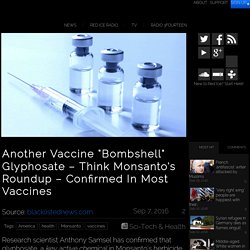
In this video, we hear Dr Samsel reciting his findings. Additionally, Dr Samsel sent a letter to his Congressional Senator from New Hampshire wherein he gives Senator Shaheen permission to share his laboratory data on glyphosate-contaminated vaccines with “all members of Congress and the public.” Florida Town Wary of Fighting Zika With Biotech Mosquito. A biotech mosquito is kicking up a political storm in the Florida Keys.
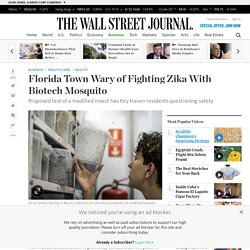
Oxitec Ltd. XON 5.73 % , a British maker of genetically modified insects, plans to go door to door in coming weeks to pitch Key Haven, Fla., voters on the virtues of a modified mosquito that the company says can help kill off wild populations known to spread maladies like the Zika virus and dengue fever. Critics of Oxitec’s proposed field trial are pushing back with yard signs and social-media campaigns, warning that the biotech mosquitoes aren’t needed to curb diseases and could harm local ecosystems. Zika Exposes Environmentalists' Deliberate DDT Death Toll. Zika is spread primarily by mosquitoes, so killing the mosquitoes is the best way to keep the virus from spreading.
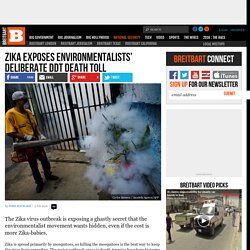
The major outbreak areas in South America have long histories of struggling with mosquito control. One reason is their inability to obtain effective pesticides, principally the mosquito-killer DDT, due to environmentalists’ fierce and utterly faked junk-science. The DDT ban was the first epic victory of environmentalist junk science, so the Greens will never walk it back, no matter how many people sicken and die because of their “triumph.”
With tens of millions of people already killed by malaria unnecessarily, a few thousand Zika victims will add little to the butcher’s bill. To this day, news organizations cite their DDT hoax as if it was true. Dr. The role of DDT in saving half a billion lives did not positively impress everyone, however. How Monsanto Got Falsely Blamed for Zika Virus. Over the weekend, a new theory arose and went viral, pointing fingers at a pesticide and the Monsanto Corp. in widespread cases of microcephaly in Brazil.
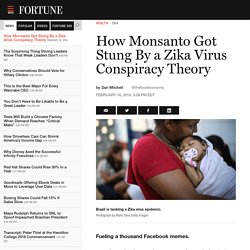
This happened despite a near-universal consensus among scientists and health officials that the cause is almost certainly the mosquito-borne Zika virus, and despite the fact that even if the pesticide (more precisely, a larvicide) were the cause, Monsanto has nothing to do with that product, and in fact doesn’t even manufacture larvicides. An article published Sunday in the online publication Tech Times carried the unwieldy but ominous headline: “Larvicide Manufactured By Sumitomo, Not Zika Virus, True Cause Of Brazil’s Microcephaly Outbreak: Doctors.”
Zika. “The new cases did not do much to help answer the big scientific question that researchers have: How precisely is Zika connected to microcephaly, and why do some babies born to Zika-infected mothers have the defect while others do not?”
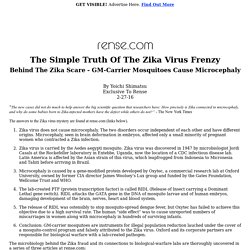
- The New York Times The answers to the Zika virus mystery are found at rense.com (links below). Zika virus does not cause microcephaly. Drugmakers Scramble to Find Zika Vaccine. Zika vaccine efficacy trials could start in 2017. In the most optimistic scenario, a Zika vaccine could prove its worth by the start of 2018, Anthony Fauci, head of the U.S.
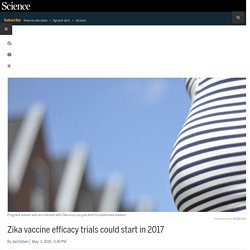
National Institute of Allergy and Infectious Diseases (NIAID) in Bethesda, Maryland, said today. Zika Virus Death Toll Could be Reduced, Will Environmentalists Let It? The world is facing a public-health emergency.

According to the World Health Organization, the Zika virus, a horrific disease that causes malformation of infants, is now “spreading explosively.” If decisive action is not taken quickly, Zika will proliferate to every continent, become widely and deeply embedded in populations, and cause millions of babies to be born brain-damaged every year for generations to come. A cure for Zika is not known, and it could take decades to find one. But there is something that can be done now to stop the epidemic. Zika is spread by mosquitoes, which can be exterminated by pesticides. Some history is in order. To only a few chemicals does man owe as great a debt as to DDT. The Truth About DDT and Silent Spring. Editor’s Note: The essay below is adapted from Robert Zubrin’s Merchants of Despair: Radical Environmentalists, Criminal Pseudo-Scientists, and the Fatal Cult of Antihumanism, published in 2012 as part of our New Atlantis Books series.
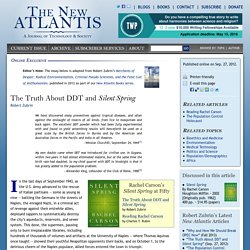
Robert Zubrin We have discovered many preventives against tropical diseases, and often against the onslaught of insects of all kinds, from lice to mosquitoes and back again. The excellent DDT powder which had been fully experimented with and found to yield astonishing results will henceforth be used on a great scale by the British forces in Burma and by the American and Australian forces in the Pacific and India in all theatres. —Winston Churchill, September 24, 1944 My own doubts came when DDT was introduced for civilian use. Silent Spring. Silent Spring is an environmental science book written by Rachel Carson and published by Houghton Mifflin on September 27, 1962.[1] The book documented the detrimental effects on the environment—particularly on birds—of the indiscriminate use of pesticides.
Carson accused the chemical industry of spreading disinformation and public officials of accepting industry claims unquestioningly. In the late 1950s, Carson turned her attention to conservation, especially environmental problems that she believed were caused by synthetic pesticides. The result was Silent Spring (1962), which brought environmental concerns to the American public. Silent Spring was met with fierce opposition by chemical companies, but it spurred a reversal in national pesticide policy, led to a nationwide ban on DDT for agricultural uses,[2] and inspired an environmental movement that led to the creation of the U.S. Environmental Protection Agency.[3][4] Research and writing[edit] Content[edit] DDT. Ingredients Used in Pesticide Products. Development of DDT DDT (dichloro-diphenyl-trichloroethane) was developed as the first of the modern synthetic insecticides in the 1940s.
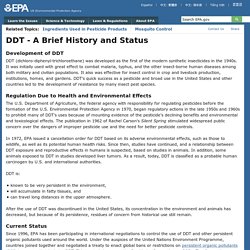
It was initially used with great effect to combat malaria, typhus, and the other insect-borne human diseases among both military and civilian populations. It also was effective for insect control in crop and livestock production, institutions, homes, and gardens. DDT's quick success as a pesticide and broad use in the United States and other countries led to the development of resistance by many insect pest species. Regulation Due to Health and Environmental Effects The U.S. In 1972, EPA issued a cancellation order for DDT based on its adverse environmental effects, such as those to wildlife, as well as its potential human health risks.
DDT Ban Takes Effect. [EPA press release - December 31, 1972] The general use of the pesticide DDT will no longer be legal in the United States after today, ending nearly three decades of application during which time the once-popular chemical was used to control insect pests on crop and forest lands, around homes and gardens, and for industrial and commercial purposes.
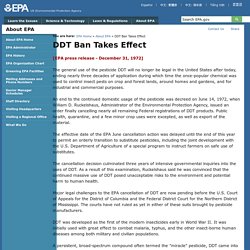
An end to the continued domestic usage of the pesticide was decreed on June 14, 1972, when William D. Ruckelshaus, Administrator of the Environmental Protection Agency, issued an order finally cancelling nearly all remaining Federal registrations of DDT products. Public health, quarantine, and a few minor crop uses were excepted, as well as export of the material. The effective date of the EPA June cancellation action was delayed until the end of this year to permit an orderly transition to substitute pesticides, including the joint development with the U.S. DDT Regulatory History: A Brief Survey (to 1975) [EPA report, July 1975] Background. Vanishing ddt page 2. (Continued from Page 1.) The DDT Insecticide Ban... What Was the Truth Behind it? Deep throat and the 'political decision' to ban DDT (3rd edition - Feb 2016) by A.O. Kime for information on 'renting' this article, see Rent-a-Article A highly effective chlorinated hydrocarbon (insecticide) developed during World War II, the usage of DDT (dichloro-diphenyl-trichloroethane) began in 1943 and became the most widely used pesticide on American farms until it was banned in 1972.
Yet... it was safe-to-use, had a broad range of applications and was a proven savior for many crops. While the banning process was a tumultuous affair lasting several years, having met stiff resistance from the farm sector, for decades the stated reason for its banning (danger to wildlife) has remained highly questionable. Well, as someone who once manufactured DDT, was once a licensed agricultural Pest Control Advisor and who was once a family farmer for 25 years (1973-1998), plus the fact I'm a perennial skeptic, perhaps this gives me some insight into the matter. The use of DDT in malaria vector control. WHO position statement. Imt/2012/04/16/50 Years After Silent Spring The Rehabilitation Of Ddt And The De Habilitation Of Rachel Carson - ThomasNet News.
When I was a teenager, the grownups around me were in raptures over Rachel Carson's 1962 book, Silent Spring -- a poetically written exposé that raised fears about chemical pesticides, which were going to kill all the birds, and possibly us, too. I thought Silent Spring was wonderful and demonstrated much that was wrong with the greedy, destructive industrialized system that the past few generations had built up in their mad fervor to conquer nature and make money. Never mind that I hadn't actually read the book. Given that history, I was surprised recently to learn that critics are blaming Carson for millions of malaria deaths, supposedly because she was responsible for using junk science to promote the banning of DDT (dichlorodiphenyltrichloroethane), a marvelous substance that has never been proven harmful to humans.
Private Philanthropy. The British Prime Minister, Tony Blair, is busily flying around the world trying to get approval among G8 members for increased aid and debt cancellations in developing countries ahead of the Gleneagles Summit. CDC - Concerns - Cancer, Simian Virus 40 (SV40), and Polio Vaccine Fact Sheet - Vaccine Safety. H.R.897 - 114th Congress (2015-2016): Reducing Regulatory Burdens Act of 2015. Tracker: This bill has the status Failed House Here are the steps for Status of Legislation: